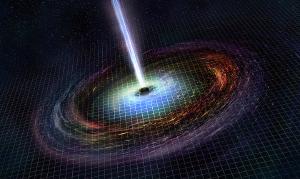Blog
Using Black Holes
As A
Particle Accelerator
15 February 2019
 NASA/CXC/M.Weiss
NASA/CXC/M.WeissAfter the discovery of the Higgs boson by the Large Hadron Collider, there’s been a lot of discussion about where to go from here. The LHC is currently the world’s most powerful particle accelerator, colliding particles at energies of about 13 TeV. While this has yielded some hints of physics beyond the standard model, it probably won’t settle some of the biggest questions in particle physics. What we need is a much more powerful particle accelerator. There is a proposal to build a Future Circular Collider operating at nearly ten times that of the LHC, but building and operating it would be extremely expensive, and that has some scientists wondering if it would be worth the cost.
But what if we could use a particle accelerator that already exists in nature? What if we could use black holes? We already know that black holes are powerful engines, creating jets of high energy particles that stream away from the black hole at nearly the speed of light. Unfortunately any exotic high energy particles they produce would decay quickly, so we wouldn’t be able to observe them directly. But a recent article in Physical Review D1 argues that we might be able to observe them indirectly through gravitational waves.
For the past few years astronomers have observed gravitational waves created by merging black holes and neutron stars. We can observe them with enough sensitivity that we can determine things such as the initial masses and rotations of the merging bodies, as well as the mass and rotation of the resulting black hole. But with greater sensitivity we should be able to measure other energy fluctuations that occur in the merger, and that’s where this new article comes in.
Rotating black holes tend to give energy to any surrounding cloud of matter through a process known as frame dragging. If a diffuse cloud of matter was located around a black hole as it started to merge with another, the frame dragging effect between the two black holes could transfer a tremendous amount of energy to the matter. It’s similar to the way a satellite can slingshot past Jupiter to reach the outer solar system, but much more powerful. Known as super-radiance, it would create a beam of particles far more powerful than anything we can create on Earth. And that could possibly create exotic particles beyond the standard model. We wouldn’t be able to observe those particles directly, but the energy of the particles would affect the gravitational waves created by the black holes. By looking for fluctuations in the gravitational waves, we could learn that exotic particles exist, or at least put limits on which exotic particles don’t exist.
A black hole particle accelerator wouldn’t be nearly as precise as one on Earth. But maybe by studying gravitational waves we can learn that there are particles beyond the standard model, and that could make building new particle accelerators worth the effort.
Daniel Baumann, et al. Probing Ultralight Bosons with Binary Black Holes. arxiv.org/abs/1804.03208 ↩︎